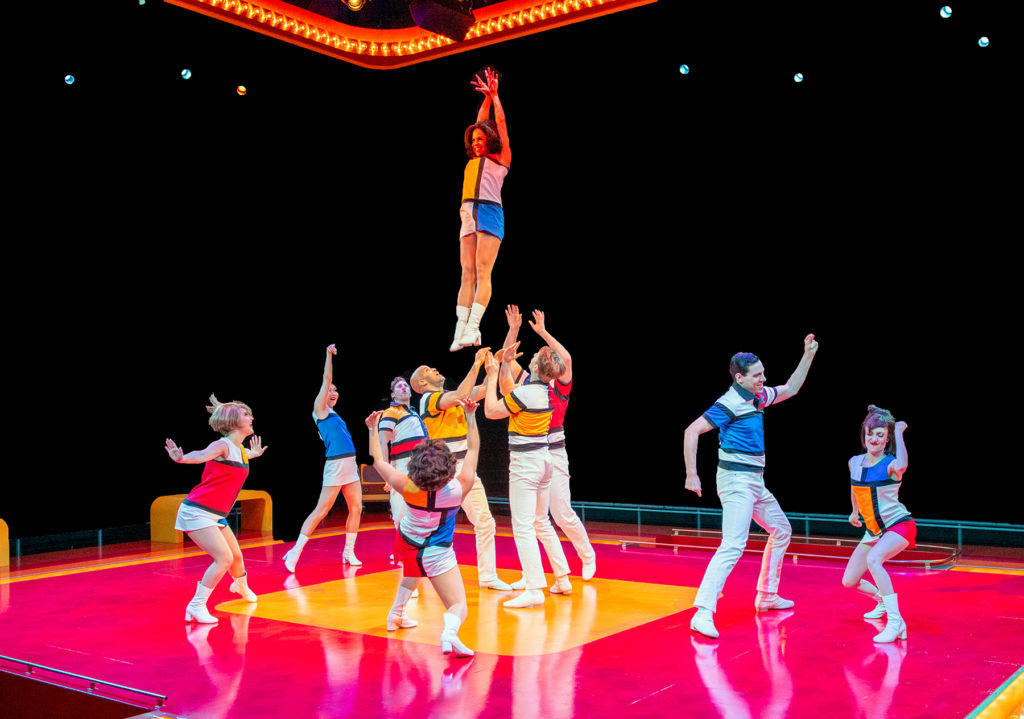
By Sheila Wickouski
In the Arena Stage production of Catch Me If You Can, costumes take center stage, creating the atmosphere of the 1960’s and supporting the story with humor and panache.
Costume designer Alejo Vietti has worked on productions ranging from Broadway to Donesk, Ukraine. He has designed costumes for the Radio City Rockettes and Ringling Brothers and Barnum & Bailey Circus, as well as operas across the United States and area theaters including the Shakespeare Theatre, Ford’s Theater, and Signature Theater.
Catch Me If You Can is Vietti’s fifth project at Arena Stage. He answered questions from The Southwester during the pop musical’s March 4 through April 17 run.
Southwester: What was your process in creating the costumes for Catch Me If You Can?
Alejo Vietti: Usually, my process starts with the script. A thorough breakdown of the script, scene by scene, and the creation of a chart of who is in each scene and transition.
After meeting with the director and other creatives – where the director establishes her point of view for this story – I start very specific image research. I investigate the period as well as every detail that will affect the costumes – for this show, that included Pan Am uniforms and nurses’ uniforms from the 1960s.
This research process will start determining my esthetic approach for the show. In the case of Catch Me If You Can, I put some emphasis in the 1960’s graphic mod period. It felt appropriate for the “game show” concept that runs through the production.
The exception in this show was the design for the musical number “50 Checks.” This process was more complicated and it involved acquiring original dollar bills from the 1960s – from a private collector – that were scanned in high fidelity, adjusted in color and then a specific artwork was generated to be printed in a regular textile as well as on a textile with sequins to create the “money” fabric to build the costumes for this number. It was a big challenge that took us on a fun – and very complex – journey.
SW: How does a costume designer work with choreographers and fight directors in creating clothes that will see a lot of action on stage?
AV: Having collaborated with Parker Esse many times in the past, I understand his vocabulary and his needs as a choreographer. Full movement is key for dancing and it is imperative that my work doesn’t get on the way, and that it facilitates the performance of the choreography without any kind of restriction from the costume.
That’s why it is very important to maintain a very open and constant line of communication with the choreography team, as well as with the performers during a fitting.
Our running motto for this show was that pretty much every performer should be able to do a grand battement in every costume look!
SW: Costumes that dazzle are part of the show. How do you work with lighting directors to get the right look?
AV: The collaboration with the lighting designer starts when you submit the color sketches so they can have a better idea of the costume color palette for each scene. The main part of the collaboration happens onstage during tech rehearsal, when all elements are onstage. It’s a complicated task, as the lighting designer must take into consideration many elements, the color of the set and costumes and how they relate to each other, skin tones, who and what needs to be highlighted, and more. Like with all other creatives, communication is key for all designers to tell the same story at the same time.
SW: Are there any tricks of the trade that you can share?
AV: To me the trick is to never stop learning. Like any other work, the more you do it, the more you learn. You become more experienced and able to anticipate situations that could be challenging, you become more knowledgeable about your craft and more resourceful. You become a better communicator and a better listener. And overall, a better designer. It’s almost like being like a sponge and absorbing as much as possible, learning from every experience along the way and building a library of knowledge, social skills, crafts and resources.
SW: You have designed costumes for Beautiful, Evita and for the Rockettes, among many others in your 23-year career. What was unique or different about working on Catch Me If You Can?
AV: Each show is different from any other show, or any other production of that same exact show. The people make the difference, their point of view and work make it unique. Having worked with Molly Smith and at Arena before made this experience that much better for me as a designer and as a person. I always look forward to coming back to Arena and to having the chance to collaborate with Molly, and with the incredible group of talented friends at the Arena Stage – most specially at the Costume and Crafts shops.
SW: What is your advice for people considering a career in costume design?
AV: If that’s what you want to do, follow your passion and keep focus on your path. Be kind, listen, be on time, do your work, and remember that it’s not about making pretty things, it’s always about character, storytelling, and collaboration. Those three things always come first.

